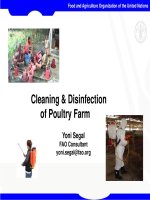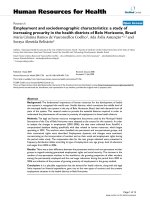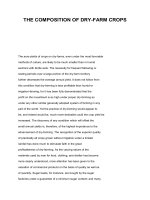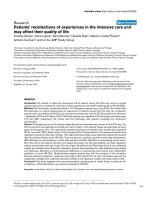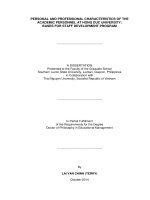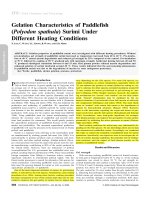Isolate the socio-demographic characteristics of the farm women may affect their nutritional security
Bạn đang xem bản rút gọn của tài liệu. Xem và tải ngay bản đầy đủ của tài liệu tại đây (167.83 KB, 6 trang )
Int.J.Curr.Microbiol.App.Sci (2019) 8(9): 1550-1555
International Journal of Current Microbiology and Applied Sciences
ISSN: 2319-7706 Volume 8 Number 09 (2019)
Journal homepage:
Original Research Article
/>
Isolate the Socio-Demographic Characteristics of the Farm Women may
affect their Nutritional Security
Karishma Baidya1, Faruk Ansari2* and Kausik Pradhan3
1
Indira Gandhi Krishi Viswavidyalaya, Raipur, Chhattisgarh 492001, India
Dr. Yashwant Singh Parmar Horticulture and Forestry University Nauni, Solan,
Himachal Pradesh-173230, India
3
Uttar Banga Krishi Viswavidyala Pundibari, Cooch Behar, West Bengal- 736163, India
2
*Corresponding author
ABSTRACT
Keywords
nutrition, farm
women, family
income, economic
empowerment,
nutrition
knowledge, kitchen
garden
Article Info
Accepted:
18 August 2019
Available Online:
10 September 2019
In India,most of the farmer having least cultivated and lower income as a result low
annual expenditure on food consumption, here in the study area they have medium to
low level of cultivated land that most affect their nutrition security. Agriculture helps
in ensuring good nutrition and good nutrition builds human capital which is also an
input for agro-production creating a circular pathway between agriculture and
nutrition. Undernourished women are often physically weak and unable to perform
income-earning activities and household work to their full potential which create
worse effects that extend through generations and lead to economic losses for families
and countries. Malnutrition disempowers women by causing or aggravating infection,
illness, lowering educational attainment and diminishing livelihood skills and drains
family savings. Women play a role to save their family easily from nutrition problems
with awareness and proper nutrition knowledge. Hence, their extent of knowledge has
great importance for the social, economic and nutritional change of the country which,
in turn, may contribute to improve the overall nutritional status of people in our
country specially women. To recognize this issue conducted a study in the villages of
Dhalaguri and Dhanghinguri of Cooch Behar-II block under Cooch Behar district in
West Bengal. Purposive, multi-stage sampling procedures are followed in the present
study. The district Cooch Behar and block Cooch Behar-II was purposively selected
due to the availability of active farming women involved in agriculture and allied
sectors. Out of the thirteen (13) Gram Panchayats of Cooch Behar-II block, two (2)
villages were randomly selected namely Dhalaguri and Dhanghinguri for the study.
Hundred number of respondent were interviewed taking fifty from each village. The
study of socio-psychological variables revealed that all of the farm women had the
knowledge and practice of including cereals in their diet because of their tradition
majority of the farm women possess medium attitude towards nutrition.
1550
Int.J.Curr.Microbiol.App.Sci (2019) 8(9): 1550-1555
characteristics of the farm women that may
affect their nutritional security.
Introduction
In the era of second green revolution, the
highest contributor in Indian economy is the
most of the population of the country is
residing in rural area and dealing with
agriculture from the primitive era the vocation
of agriculture is predominate by the women.
In this context, one of the agricultural pathway
towards sustainable nutritional security is
through local production of nutritious food
activity in which the farm women where the
most vulnerable. Agriculture helps to ensuring
good nutrition and good nutrition can build
human capital which is also input for agro
production, creating a circular pathway
between agriculture and nutrition. Despite
rapid growth in socio-economic development,
health and education, the widening economic,
regional and gender disparities are posing
challenges for the health sector. Therefore,
rural women could be an effective partner and
contributor towards the nutritional security of
the rural folks because a woman plays an
important role in selection, preparation and
serving of food for their family members
(Kumari and Srivastava, 2010). Their extent of
knowledge has great importance for the social,
economic and nutritional change of the
country which, in turn, may contribute to
improve the overall nutritional status of people
in our country specially women (Afrin Sultana
et al., 2016) (Chatterjee, 1990; Desai, 1994).
Finally, a woman’s health affects the
household’s economic well being too. In any
country the state of health is measured in
terms of life expectancy, mortality rate,
fertility rate and many more. But it can’t be
ignored that all these indicators of health are
dependent on other factors like per capita
income, nutrition, sanitation, safe drinking
water, social infrastructure, medical care
facilities, employment status, poverty, etc
which affect the health of every individual.
Keeping this in view, a study was conducted
to know the isolate the socio-demographic
Materials and Methods
The study was conducted in the villages of
Dhalaguri and Dhanghinguri of Cooch BeharII block under Cooch Behar district in West
Bengal. Purposively, multi-stage sampling
procedures were followed in the present study.
The district Cooch Behar and block Cooch
Behar-II was purposively selected due to the
availability of active farming women involved
in agriculture and allied sectors. Out of the
thirteen Gram Panchayats of Cooch Behar-II
block, two villages were randomly selected
namely Dhalaguri and Dhanghinguri for the
study. 100 farm women were interviewed
taking fifty from each village.
Results and Discussion
The table 1, reveal that the majority of the
farm women (57 %) where under the young
age group of 26-37 years followed by the
middle age group of (26%) who where
between 38-49 years and (17%) of them old
age group of 50-61 years. The variability in
age of the respondent is distributed with a
mean value of 38.41 and standard deviation of
8.64. The coefficient of variation value
22.49% of the distribution signifies the high
consistency level of the distribution for the
variable ‘age’. Majority of the farm women in
the study area are young to middle age group,
this gives a scope for extension workers for
diffusion of novel technologies to improve
nutritional security.
The table 2 reveals that majority of the farm
women are under the medium level of family
education status 2.8-3.9 (56%) followed by
high level of education status 4.0 to 5.1 (27%)
and low level 1.6 to 2.7 (17%) respectively.
The mean score of total distribution was 3.27
and standard deviation of the distribution was
1551
Int.J.Curr.Microbiol.App.Sci (2019) 8(9): 1550-1555
0.67. The coefficient of variation value within
the distribution being 20.49% signifies the
very high consistency level of the distribution
for the variable ‘family education statuses.
Kauret al., (2015) observed that education of
mother was positively and significantly
correlated with the knowledge regarding
anemia, pregnancy, hygiene & sanitation and
feeding practices and thereby the nutrition
knowledge of the mother was found to have a
significant bearing on their children nutritional
status. The need of nutrition education for
women was, therefore, important and urgent in
rural areas. The result indicates that most of
the farm women in the study area belong to
those families where family education status
was medium to high, this may because of
majority of the responded young to middle
aged who where hold good educated.
The table 3 shows that majority of the farm
women were under the low level of family
annual income 0.78-1.15 (50%) followed by
medium level of family annual income of
1.16-1.53 (45%) and high level 1.54-1.91
(5%) respectively. The mean score of total
distribution is 1.16 and standard deviation of
the distribution is 0.23. The coefficient of
variation value within the distribution being
19.8% signifies the very high consistency
level of the distribution for the variable
‘family annual income’. One of the reasons for
low to medium family annual income is that
the families’ in the study area had low to
medium land holding and the primary source
of their income is farming. On the contrary,
Sheth, et al.,(2006) reported that the monthly
family income (from all sources) of majority
(78.5%) of households ranged between
Rs.1000-1500 per month.
The table 4 presents the distribution of the
farm women according to their family
member. The result shows that majority of the
farm women fall under the low family
member category 3-4 (66%) followed by high
family member 5-6 (34%) respectively. The
mean score of total distribution is 4.21 and
standard deviation of the distribution is 0.84.
The coefficient of variation value within the
distribution being 19.95% signifies the very
high consistency level of the distribution for
the variable ‘family member.
Table 5 presents the distribution of the farm
women according to their land holding. The
results show that majority of the farm women
are under the low level of land holding 0.561.72 (61%) followed by medium level of land
holding 1.73-2.89 (31%) and high level 2.904.06 (8%) respectively.
The mean score of total distribution is 1.59
and standard deviation of the distribution is
0.78. The coefficient of variation value within
the distribution being 49.06% signifies the
medium consistency level of the distribution
for the variable ‘land holding’.
Table 6 presents that the distribution of the
farm women according to their annual
expenditure. The results show that majority of
the farm women fall under the medium level
of family expenditure 0.72-0.97 (44%)
followed by low level of annual expenditure
0.46-0.71 (20%) and high level 0.98-1.23
(6%) respectively. The mean score of total
distribution is 0.76 and standard deviation of
the distribution is 0.14.
The coefficient of variation value within the
distribution being 18.42% signifies the very
high consistency level of the distribution for
the variable ‘annual expenditure’.
It indicated that the farm women having
medium expenditure. It is notices in the study
area both the family annual income and annual
expenditure, majority of the farm women are
in low and medium category.
1552
Int.J.Curr.Microbiol.App.Sci (2019) 8(9): 1550-1555
(n=100)
Table.1 Distribution of farm women according to their
age (X1)
Category
Score Frequency Percentage
Table.2 Distribution of the farm women
according to family education status (X2)
Score
Frequency
Percentage
Young aged
26-37
57
57
1.6-2.7
17
17
Middle aged
38-49
26
26
2.8-3.9
56
56
Old aged
50-61
17
17
4.0-5.1
27
27
Statistics
Range=26-60, Mean =38.41
Range=1.6-5.0, Mean =3.27
SD =8.64, CV =22.49%
SD =0.67, CV =20.49
(n=100)
Table.3 Distribution of the farm women according to
family annual income (X3)
Category
Score
Frequency Percentage
Table.4 Distribution of the farm women
according to family member (X4)
Score
Frequency
Percentage
Low
0.78-1.15
50
50
3-4
66
66
Middle
1.16-1.53
45
45
0
0
0
High
1.54-1.91
5
5
5-6
34
34
Statistics
Range=0.78-1.90, Mean =1.16
Range=3-6, Mean =4.21
SD =0.23, CV =19.83
SD =0.84, CV =19.95
(n=100)
Table.5 Distribution of the farm women according to
land holding (X5)
Category
Score
Frequency Percentage
Table.6 Distribution of the farm women
according to annual expenditure (X6)
Score
Frequency
Percentage
Low
0.56-1.72
61
61
0.46-0.71
44
44
Medium
1.73-2.89
31
31
0.72-0.97
50
50
High
2.90-4.06
8
8
0.98-1.23
6
6
Statistics
Range=0.50-4.00, Mean =1.59
Range=0.46-1.20Mean =0.76
SD =0.78, CV =49.06
SD =0.14CV =18.42
1553
Int.J.Curr.Microbiol.App.Sci (2019) 8(9): 1550-1555
(n=100)
Table.7 Distribution of the farm women according
to food expenditure (X8)
Category
Score
Frequency Percentage
0.35-0.53
67
67
Low
Table.8 Distribution of the farm women
according to extension contact (X9)
Score
Frequency Percentage
8-11
54
54
Medium
0.54-0.72
30
30
12-15
42
42
High
0.73-0.91
3
3
16-19
4
4
Statistics
Range=0.35-0.89, Mean =0.51
SD =0.09, CV =17.69
Range=8-18, Mean =11.17
SD =2.21, CV =19.79
Table.9 Distribution of the farm women according to mass media exposure (X10)
(n=100)
Category
Low
Score
2-4
Frequency
48
Percentage
48
Medium
5-7
46
46
High
8-10
6
6
Malnutrition disempowers women by causing
or aggravating infection, illness, lowering
educational attainment and diminishing
livelihood skills and drains family savings
(Alam, et al., 2011). And,Daba, et al.,(2013)
reported that less (34.8%) respondents had the
knowledge that inadequate nutrition during
pregnancy can be the cause of miscarriage and
pre-term birth.
The table 7 reveals the distribution of the farm
women according to their food expenditure.
The results show that majority of the farm
women fall under the low food expenditure
category 0.35-0.53 (67%) followed by
medium category of food expenditure 0.540.72 (30) and high category 0.73-0.91 (3%)
respectively. The mean score of total
distribution is 0.51 and standard deviation of
the distribution is 0.09. The coefficient of
variation value within the distribution being
17.69% signifies the very high consistency
level of the distribution for the variable ‘food
expenditure. It indicates that the farm women
having low food expenditure which needs to
be enhance through various awareness and
Statistics
Range=2-10
Mean =5.19
SD =1.49
CV =28.32
campaigns on spending on nutritious food.
(Chatterjee, 1990). Because of prevailing
culture and traditional practices in India, the
health and nutritional status of women
becoming worse effected.
The table 8 reveals the distribution of the farm
women according to their extension contact.
The results shown that majority of the farm
women fall under low level of extension
contact 8-11 (54%) followed by medium level
of extension contact 12-15 (42) and high
category 16-19 (4%) respectively. The mean
score of total distribution was 11.17 and
standard deviation of the distribution was
2.21. The coefficient of variation value within
the distribution being 19.79% signifies the
very high consistency level of the distribution
for the variable ‘extension contact. It indicates
that most of the farm women in the study area
do not have contact with extension
functionaries which often restrict them from
getting firsthand information regarding
nutritional aspect of food intake.
The table 9 presents the distribution of the
1554
Int.J.Curr.Microbiol.App.Sci (2019) 8(9): 1550-1555
farm women according to their mass media
exposure. The results show that majority of
the farm women fall under the low mass
media exposure 2-4 (48%) followed by
medium mass media exposure 5-7 (46) and
high 8-10 (6%) respectively. The mean score
of total distribution was 5.19and standard
deviation of the distribution was 1.49. The
coefficient of variation value within the
distribution being 28.32% signifies the high
consistency level of the distribution for the
variable ‘mass media exposure’. It indicates
that most of the farm women in the study area
do not have adequate exposure to mass media
which often restricts them from getting
appropriate information regarding nutritional
aspect of food intake.
Most of the farm women in the study area
have no land to cultivate, illiterate along with
less farming experience, so nutrition education
and awareness programmes need to conduct in
that area to create nutrition sensitivity among
them and as they were mostly young ages so it
will be easy to change their mindset and
motivate them to grow some green nutritious
vegetables in their kitchen garden through
training programmes, also might be encourage
them to engage in some income generation
activities to support their family income and
make them economically empowered which
will reflect to improve their family nutrition
status.
References
Alam K, Tasneem and Oliveras E.(2011).
Performance
of
female
volunteer
community health workers in Dhaka urban
slums: A case-control study. A Manoshi
working paper.No. 12.International Centre
for Diarrhoeal Disease Research, Dhaka,
Bangladesh; Research and Evaluation
Division, BRAC.
Chatterjee, M.(1990). Indian women: Their
Health and Economic productivity. World
Bank Discussion Papers, 109, Washington,
D.C: World Bank.
Daba G, Beyene F, Fekadu H, GaromA. W
(2013) Assessment of Knowledge of
Pregnantb Mothers on Maternal Nutrition
and
Associated
Factors
in
GutoGidaWoreda, East Wollega Zone,
Ethiopia. J Nutr Food Sci3: 1-7
KaurK, Grover K andKaur N(2015). Assessment
of Nutrition Knowledge of Rural Mothers
and Its Effectiveness in Improving
Nutritional Status of Their Children. Indian
Research Journal Extension Education,
15(4):90-98.
Kumari M., Srivastava A. K and Sinha N.
(2010).Extent of Knowledge of Farm
Women on Nutrition. Indian Research
Journal Extension Education. January 10
(1);65-68.
Sheth M, Gurudasani R, Mistry V, Mehrotra S
and Seshasri S (2006) Food safety
education as an effective strategy to reduce
diarrhoeal morbidities in children less than
two years of age. Ind J NutrDietet,43: 2231.
Sultana A, Md. Safiul Islam Afrad, Muhammad
ZiaulHoque
and
Bhattacharjee
D
(2016).Knowledge of Farm Women on
Nutritional Value of Farm Products in
Bangladesh.Indian Research Journal Isolate
the Socio-Demographic Characteristics of
the Farm Women may affect their
Nutritional
Security
Extension
Education.16 (2):25-30.
How to cite this article:
Karishma Baidya, Faruk Ansari and Kausik Pradhan. Techniques for Determination of Vitamin
B6, Vitamin C and Variability in Areca Nut (Areca catechu) Samples of Karnataka, India.
Int.J.Curr.Microbiol.App.Sci. 8(09): 1550-1555. doi: />
1555

